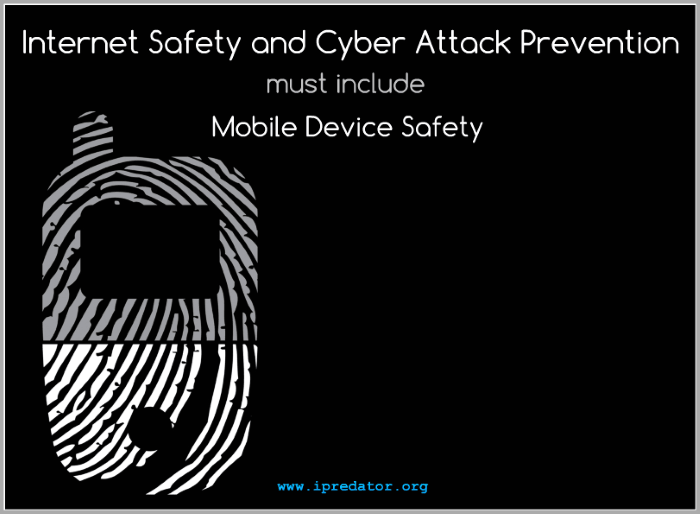Internet Safety, Cyber Attack Prevention
and iPredator
Internet safety and cyber attack prevention is vital to all online users and below is a list of factors sought by iPredators searching for their next target. Just as classic criminals can “case” a home or choose the most vulnerable child to abduct, the iPredator is able to do the same using information they compile from a variety of online sources and contacts. Based on the typology of iPredator, the areas they investigate in their strategy of targeting a victim is listed below for the reader. Here at the iPredator Inc. Internet Safety Page, Dr. Nuccitelli and his colleagues will post their Internet safety and cyber security articles.
The typologies of iPredator include cyberbullying, cyber harassment, cyberstalking, cybercrime, online sexual predation, internet trolls, online child pornography owners and cyber terrorism. Within this construct, cyber harassment is the adult form of cyberbullying and used when the perpetrator is an adult.
As Information and Communications Technology (ICT) becomes widespread, cyber attack prevention, education and protection are areas requiring immediate attention. The Information Age has many benefits to humanity, but it is vital to identify and prevent the malevolent and nefarious elements that exist in cyberspace and Information and Communications Technology.
Information Age Internet Safety
The Information Age is a societal paradigm and period beginning in the last quarter of the 20th century and presently thriving in the second decade of the 21st century. The Information Age represents the evolution, emergence, consumption of and reliance upon Information and Communications Technology (ICT). In a mere four decades, ICT and its importance to humanity have led many to surmise that the planet and its human inhabitants are amidst an Information Revolution.
Mobile device technology, telecommunications, social media & cyberspace are just a few examples of humanities newest communication channels. In all these arenas, they deal with the new frontier of how humankind obtains exchanges and disseminates information.
Information and Communications Technology (ICT) and the Information Age have created a new dimension leading to an entirely new population of humanity engaged in malevolent, harmful and deceptive practices. ICT and cyberspace are not tools used by the classic sociopath, deviant, narcissist or criminal, but a new generation called iPredators. These online assailants will be permanent fixtures to humanity for centuries to follow.
In order to effectively educate, evaluate, investigate or advise any ICT user on Internet safety, whether they are a child, adult, group or business, it is paramount to grasp the basic concepts and terms vital to all ICT users. The two terms important to be familiar with are iPredator & Cyberstealth. For it is in cyberspace & the internet, using ICT, that vast majority of iPredators develop, activate and institute Cyberstealth.
Cyber Attacker Strategies
Often, cyberbullies, ex-partners, ex-employees, angry or self-righteous online users, Internet trolls, organized groups with political, religious and moralistic causes, child molesters, pedophiles and highly narcissistic online users do not attempt to hide their identities. Cyberstealth is a strategy reserved for iPredators who seek to hide their identities online. In addition to a stratagem, Cyberstealth is a reality of Information and Communications Technology that humanity often fails to fathom leading some online users to become high probability targets. Cyberstealth is a learned behavior that becomes more advanced with practice, trial and error and experimentation. In addition to having IVI, the iPredator practices Cyberstealth using multiple covert strategies. iPredators are assessed as being advanced in their Cyberstealth practices as opposed to a haphazard approach of targeting a victim without attempting to hide their identity. Methods iPredators use in their Cyberstealth strategies are as follows:
1. The amount of personal information a potential target post or shares online.
2. The frequency a potential target post or shares their contact information online.
3. The content of the information a potential target post or shares online.
4. The lack of Internet safety measures a potential target institute online.
5. The potential targets willingness to discuss sensitive issues including sexual topics, financial information, their physical location, parental or adult monitoring of their online activities, experiences of distress at home, work, school and interpersonal or intrapersonal issues.
6. The amount of time the potential target spends online.
7. The type of information a potential target post or shares on their social networking profiles (i.e. Facebook, Instagram, Twitter, LinkedIn.)
8. The potential target’s offline demeanor leading the iPredator to conclude the online user will be an easy target.
9. The non-response or lack of assertive confrontation by a potential target to respond to negative information.
10. The potential target’s probability of not having social system support, legal/law enforcement support or knowledge of intervention strategies if cyber attacked.
11. The quantity and themes of images and/or videos an online user posts or shares online.
12. The pattern of “likes” and “dislikes” an online user posts or shares on their social networking site profiles.
13. The frequency a potential target changes their profile images and information on their social networking profiles.
14. Images and/or videos showing the potential target’s economic status, the layout of their residence or their material objects they or their loved ones own.
15. Images, videos and posts of the potential target’s choice of lifestyle and/or material objects.
16. Images, videos and posts of the potential target’s lifestyle.
17. Images, videos and posts of the potential target’s needs, wants and desires.
18. Images, videos and posts suggesting the potential target is suffering from psychological and/or psychosocial dysfunction.
Although there are other factors an iPredator uses in their repertoire of exhibiting IVI, the eighteen factors listed are recommended to evaluate by all online users to reduce their chances of becoming an iPredator target. Not included in these factors and apply to all online users is the unfortunate reality of being targeted by an iPredator as part of a mass trolling scheme. This occurs most often in cybercrime when the potential target receives an email asking them to open an attachment or gulled into providing personal information. This cybercrime and cyberbullying tactic is called “Phishing.”
“Society is being lulled into a false sense of trust and reliance on technology, taking information and “connection” to others in cyberspace at face value. Like the child in the fairy tale, Little Red Riding Hood, innocently wandering through the forest, we erroneously believe that the “Wolf” is whoever he appears or claims to be. Just as Little Red Riding Hood, we’re in danger of falling prey to iPredator.” Michael Nuccitelli Psy.D., (2012)

Free Edu. Internet Safety Inventory Links
- iPredator Probability Inventory – 330 (IPI-330)
- iPredator Probability Inventory – Adult (IPI-A)
- iPredator Probability Inventory – Business (IPI-B)
- iPredator Probability Inventory – Cyberbully (IPI-CB)
- iPredator Probability Inventory – Cyberbully Abuser (IPI-CBA)
- iPredator Probability Inventory – Cybercrime (IPI-C)
- iPredator Probability Inventory – Cyberstalking (IPI-CS)
- iPredator Probability Inventory – Educator (IPI-E)
- iPredator Probability Inventory – Internet Predator (IPI-IP)
- iPredator Probability Inventory – Pediatric (IPI-P)
- iPredator Probability Inventory – Psychologist (IPI-PSY)
- iPredator Probability Inventory – Teen (IPI-T)
Free Edu. Internet Safety Checklist Links
- Adult Internet Safety Checklist (AISC)
- Business Internet Safety Checklist (BISC)
- Cyberbully Abuser Checklist (CBAC)
- Cyberbullying Target Checklist (CBTC)
- Cybercrime Protection Checklist (CCPC)
- Cyberstalker Identification Interview (CSII)
- Cyberstalking Prevention Checklist (CSPC)
- Digital Reputation Protection Checklist (DRPC)
- Educator Internet Safety Checklist (EISC)
- Internet Safety Checklist Psychologist (ISCP)
- Online Predator Prevention Checklist (OPPC)
- Parent Cyber Safety Checklist (PCSC)
- Pediatric Internet Safety Checklist (PISC)
- Teen Internet Safety Checklist (TISC)
Michael Nuccitelli, Psy.D.
Michael Nuccitelli, Psy.D. is a NYS licensed psychologist, cyberpsychology researcher and online safety educator. In 2009, Dr. Nuccitelli finalized his dark side of cyberspace concept called iPredator. Since 2010, he has advised those seeking information about cyberbullying, cyberstalking, cybercriminal minds, internet addiction and his Dark Psychology concept. By day Dr. Nuccitelli is a practicing psychologist, clinical supervisor and owner of MN Psychological Services, PLLC. After work and on the weekends, he volunteers helping online users who have been cyber-attacked. Dr. Nuccitelli’s is always available to interested parties and the media at no cost. This website and everything created by Dr. Nuccitelli is educational, free and public domain.

